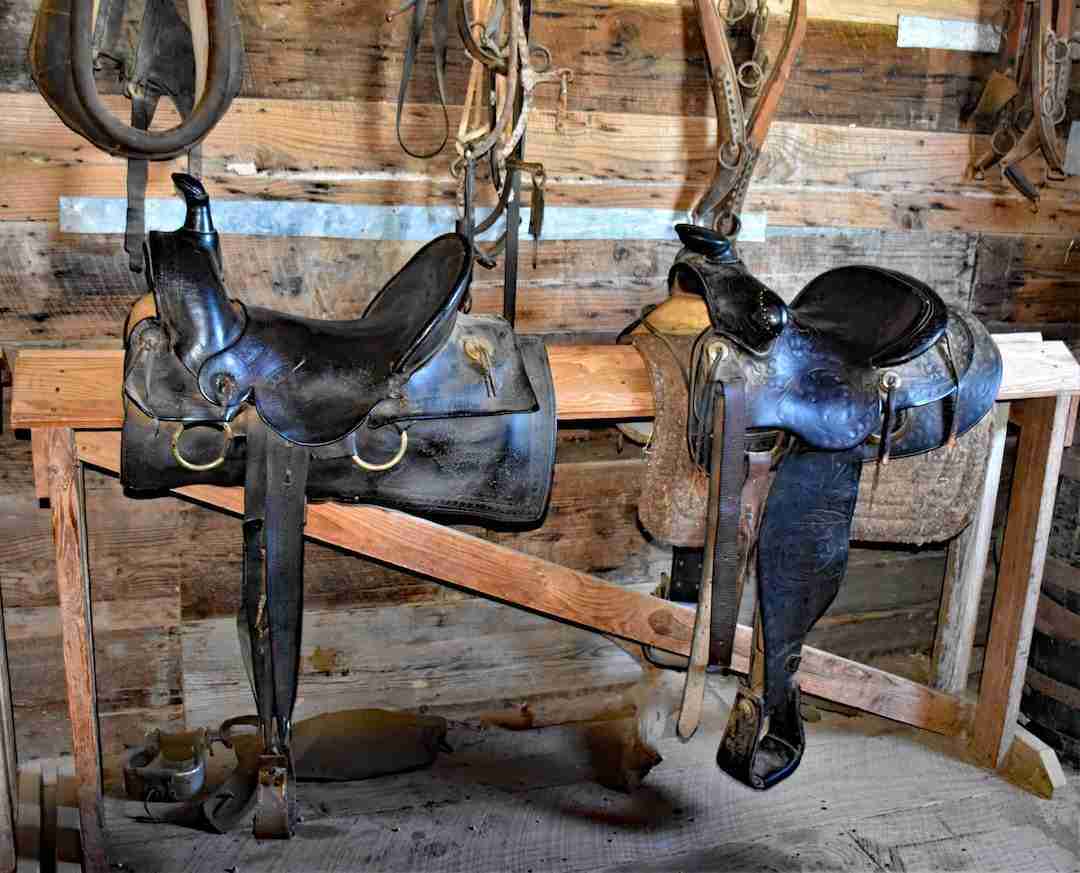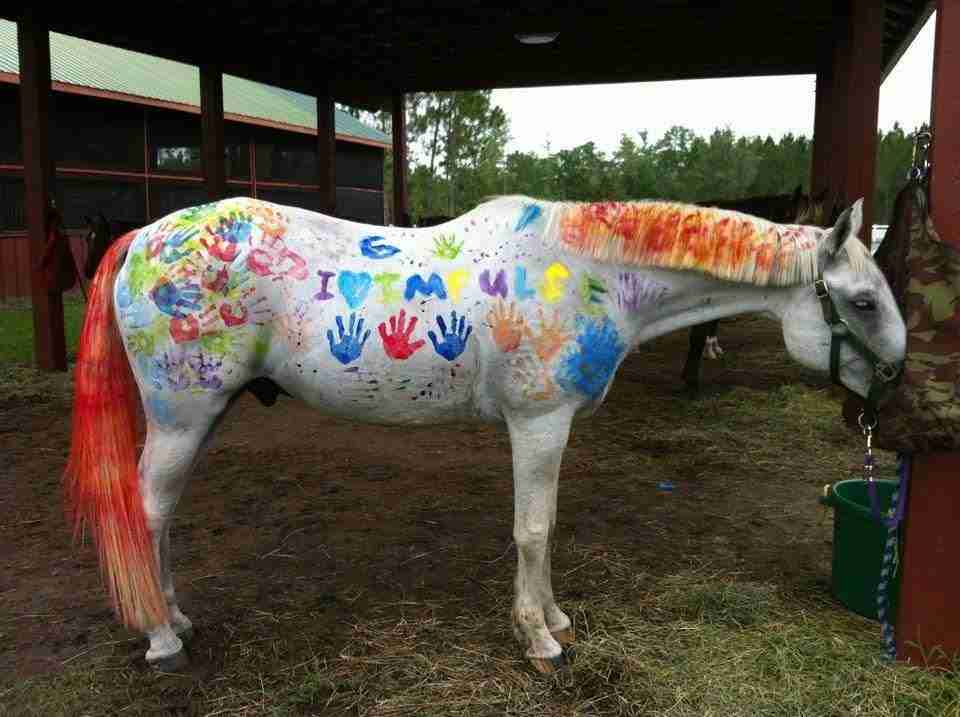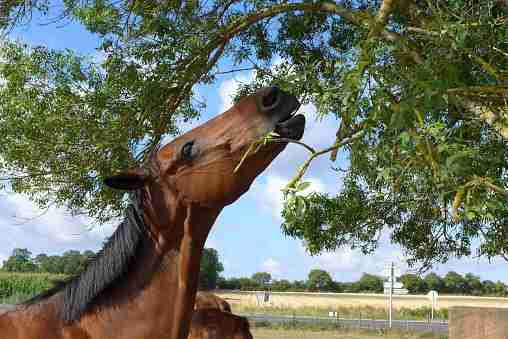It isn’t surprising that many wonder whether or not horses sweat. Horses are often graceful and beautiful with their sleek, shining coats. There’s nothing better than riding a magnificent animal like a horse. However, do horses sweat?
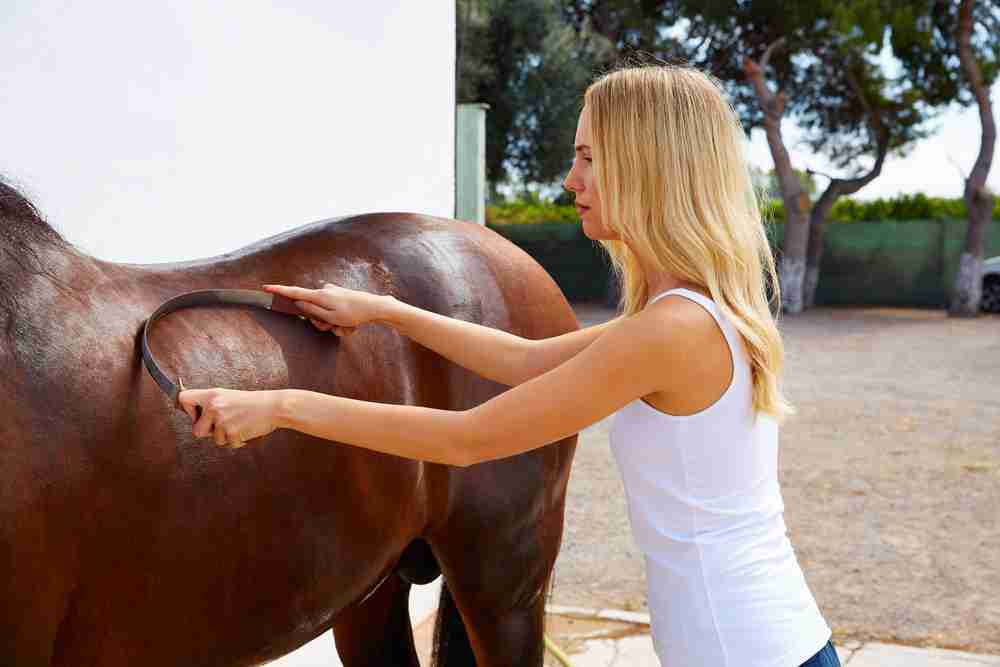
Horses sweat, particularly after intense exercise, to help them cool off. Horses’ dense hair, which traps the moisture, slows down the process. To counteract this, the horse’s body produces a substance called latherin. This aids in cooling down and preventing moisture from being trapped.
Compared to humans, a horse’s sweat is unique, as they do not sweat the same as humans. Here is what to know about why horses sweat, whether or not their sweat is the same as humans or any other mammal, and whether all horses sweat.
All About Whether Or Not Horses Sweat
Undoubtedly, horses sweat. In fact, whether it’s hot outside or they’re working hard, they sweat a lot. Since they are running animals, it isn’t surprising that they have a sweat gland common in other running animals.
Interestingly, horses and other equine family members are among the few animals superior to humans at long-distance running. Horses are the sole animals that sweat as much as humans because overheating is the main factor that makes long-distance running challenging.
They become too hot if they don’t. Furthermore, horse owners have been known to immediately call the vet for an emergency visit if their horses do not sweat excessively while it is hot outside or while they are working hard.
It has been proven that horses use sweat to control their body temperature. Interestingly, the whole sweating process is quite simple. When the horse’s blood is circulating, the blood tends to absorb heat from the muscles. This heat is then carried off to the horse’s skin, where it can radiate from the horse’s body.
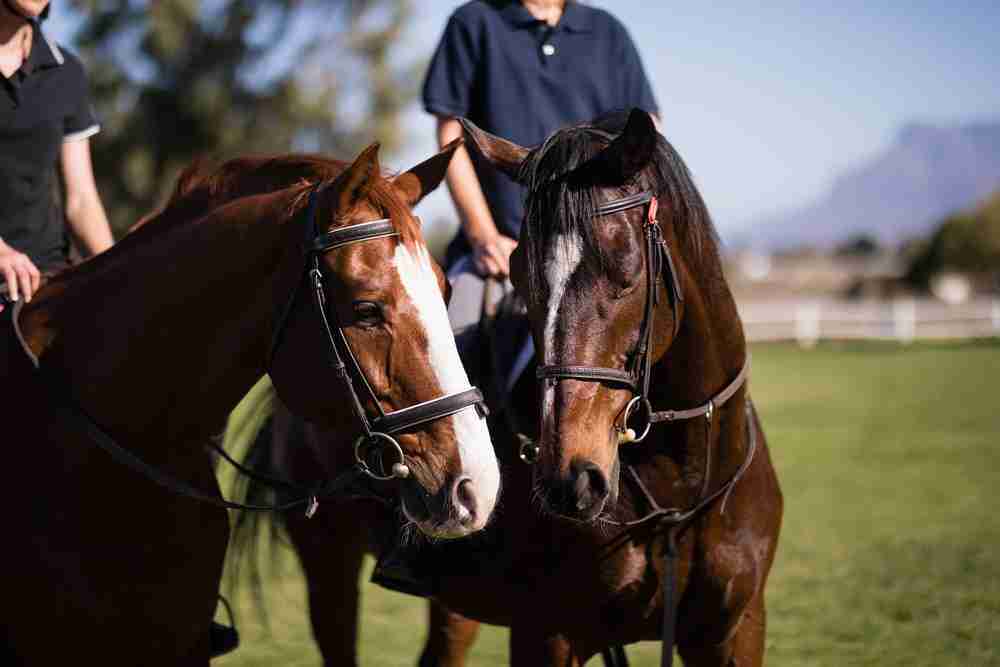
The heat is also carried to the lungs, where some escapes when the horse exhales. The horse’s core temperature starts to increase from its typical resting temperature if it creates more heat than it can expel through breathing and radiative cooling.
The horse’s central thermostat situated in the brain, the hypothalamus, detects the rise. It quickly sends messages to the sweat glands dispersed throughout the horse’s skin. Perspiration starts to come out of the sweat glands. The heat removed from the skin by sweat as it evaporates lowers the horse’s body temperature. This leads to a horse cooling down at a decent rate.
Horses have been known to sweat at a much higher rate than humans. Typically, horses can sweat as much as 10 to 12 liters per hour. Horses generate roughly 1 gallon of sweat every fifteen minutes while exercising in warm conditions. Equipment-covered parts start to sweat first, followed by the torso, neck, and space behind the horse’s legs.
In order to stop the salts in the horse’s sweat from penetrating the fabric and leaving noticeable stains on the surface, the tails of long contest riding coats are typically lined with either vinyl or leather. The white saddle pad also serves to safeguard the coat’s tails.
What Are The Signs Of A Horse Sweating Excessively?
Dehydration in difficult situations can be lethal. Your horse’s body stops sweating when it has heat stroke, and its temperature increases swiftly to 106–110 F. Sweat forms on the head, sides, and rump whenever a horse is hot and at risk of heat stroke. It runs the danger of being dehydrated from excessive sweating, which can harm organs and interfere with vital processes like digestion and circulation.
Here are some signs a horse is sweating too much:
- The horse is breathing heavily and continues to do so. In warm weather, quick, shallow breathing is typical after training. Still, a horse’s breathing should return to its usual resting rate relatively quickly, usually below 20 breaths per minute on average. The horse might be breathing this rapidly to cool off if the rate continues to be high.
- The horse doesn’t seem to be losing any heat. A horse’s temperature can rise to 106 degrees when working hard, but it should drop fast once the exercise is done. If the temperature doesn’t decrease by a degree or two in the next 20 to 30 minutes, it’s time to worry.
- If the horse seemed worn out and dejected. A horse might refuse food because horses typically don’t eat while dehydrated but usually prefer water. However, one that is severely dehydrated, though, could even refuse to drink.
Note: If you notice any of the above, act fast by spraying the horse or bathing it with cold water. Scrape the water, hose the horse off again, and keep doing this until the water stops heating up. In some situations, alcohol baths can disperse heat more effectively than water baths.
Another way you can help your horse is by setting up a fan to blow air. This would be a good idea as it will help diminish the heat. Using a misting fan would yield better results as they employ water vapor to cool the air.
Allow your horse to hydrate by drinking water regularly throughout the day, especially when it is hot, or they have been training. Give your horse a tiny portion to drink, up to a gallon, then follow that with a short walk and another offer of water.
In What Way Do Horses Sweat?
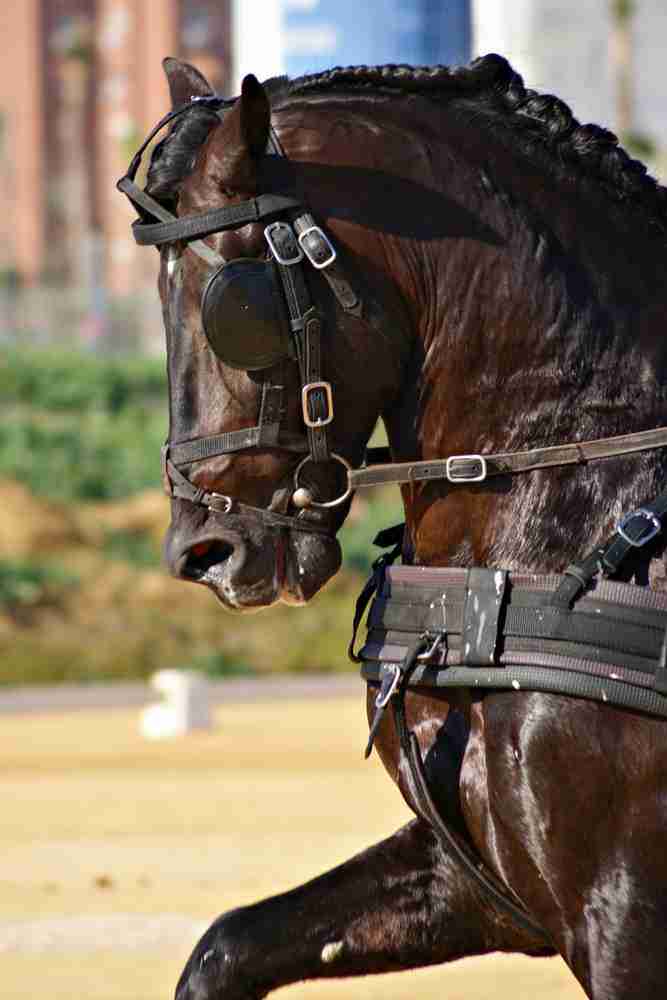
Horse sweat is very different from that of a human. Eccrine and apocrine glands are the two primary categories of sweat glands. Watery sweat is produced by eccrine glands. Sweat from apocrine glands can be milky or even oily.
Horses sweat through a cluster of apocrine and eccrine sweat glands located beneath the epidermis. These sweat glands secrete a salty, water-rich fluid that lowers body temperature via evaporative cooling.
Mostly made up of water, human perspiration also contains salts and other substances. Our watery perspiration can begin to evaporate as soon as it exits the body since it does not need to pass through a coat of hair to reach the air. Therefore, sweating helps us to cool off.
Horses, however, have a hair coat that is pretty thick and waterproof. So, if a horse’s sweat was similar to ours, it would have difficulty penetrating the coat of hair. In that case, it would merely drip off, preventing it from cooling them.
Because of this hair covering, although short, it is more difficult for the horse’s sweat glands to swiftly move sweat from their skin to the short hair’s ends, where it can evaporate. To create cooling, the sweat must remain on the horse’s body long enough to evaporate. Latherin is the horses’ answer to this problem.
Horse sweat is unique because it contains a detergent-like protein called latherin. Latherin increases the efficacy of sweat. Horse hair is lathered up by the protein. True to its name, it acts as a detergent, getting the horses wet so that water can efficiently travel from the base of the hairs to the ends, in which evaporative cooling takes place.
The coat must be wet for the water in the perspiration to pass through the coat’s hairs and reach the surface so that it can evaporate and cool them off. The latherin acts as a wetting substance for the coat’s hair.
Additionally, it facilitates evaporation by prolonging the time the water from perspiration remains on the horse’s body. Horse sweat rich with latherin is similar to detergent in that it foams, which is what lends it the frothy white appearance often seen on horses when tack or limbs rubs against the animal’s skin.
How To Take Care Of A Horse When It Sweats?
Ensure the horse has a proper cooling down after riding. Horses that are sweating must be cooled down slowly to prevent them from being excessively chilled, which could make them extremely unwell. Walk for about five to ten minutes to avoid making their muscles sore.
Brushing a horse after exercising is sufficient if they are a little damp. If it is covered in perspiration, it will require more than ten minutes for your horse to cool off. To remove the initial layer of sweat, use a towel rug. You can place an exercise rug if it is sweating to assist it in drying off.
Horses, in some instances, should preferably be dried with straw after riding and exercising since they sweat all over their bodies. This does a great job of preventing them from becoming chilled. You may opt for a cooler sheet if the horse is not drenched in perspiration but is also not dry enough to be returned to the stable without a rug.
Furthermore, a horse’s sweat is hypotonic or isotonic compared to its blood. When humans sweat, their blood tends to get higher in osmolarity. This is simply the stimulus to drink. Horses, on the hand, may not get the stimulus. Therefore, horses may need to drink water, but that does not mean they are thirsty.
Horses can go through heat stress if they do not have enough water to continue sweating. It’s imperative to also ensure that your horse has salt. This is because horses lose a lot of salt when they sweat. Therefore, it is typically recommended that horse owners double the salt intake in the summer or if they are being worked hard.
It is imperative to ensure that there is always water available for your horses. Horses generally prefer to have larger reservoirs of water. Hang buckets in their stalls and fill them up multiple times throughout the day. There are also some ways to check whether a horse is dehydrated.
One of the easiest ways to do this is to conduct a skin fold test. Simply grab some of the skin on your horse’s neck, slightly pull on the skin and release it. If the skin snaps back quickly, the horse is well hydrated. If the skin stays pinched, your horse is dehydrated.
You can also look over the horse’s eyes to see if they are sunken or look dull. This will typically mean the horse is dehydrated. A horse needs between 5 and 10 liters of water daily, 35 to 70 gallons or more, every week.
However, the precise amount required depends on the horse’s size, unique metabolism, whether the water has a bad taste or temperature, the surrounding temperature, and the horse’s level of exertion.
Do All Horses Sweat?
Yes, every horse sweats differently and in different patterns. However, there have been some cases where horses don’t sweat much, and others don’t even sweat at all. A horse sweats to regulate body temperature. Suppose it is unable to do so because of a medical condition called anhidrosis, which is caused by stress or metabolic issues and prevents sweating.
In that case, it must be cooled mechanically by being repeatedly and frequently sponged with water to simulate the evaporation of sweat. This is a crucial component of the horse’s thermoregulatory system that keeps it cool. A horse that doesn’t perspire runs the risk of developing serious anhydrosis. Non-sweating may even endanger life.
A reduced ability to sweat in response to a raised body temperature is known as anhidrosis. Both horses and humans have been described as lacking the ability to sweat, which is most noticeable in hot, humid areas. Because sweating serves as the primary mechanism for thermoregulation in horses, it is a significant issue.
Approximately 65 to 70 percent of a horse’s body heat is lost through sweat evaporation. The efficacy of sweat evaporation and, thus, the horse’s cooling is significantly reduced in a humid atmosphere. Based on the right clinical indications and a veterinarian’s examination, anhidrosis is frequently presumptively diagnosed.
Anhidrotic horses produce little or no sweat under conditions that normally cause profuse sweating. After exercise, affected horses frequently experience increased respirations and difficulty cooling down. Furthermore, the horse may still be sweating in some places, which is confusing.
Horses with chronic instances often have hair loss, weariness, anorexia, and decreased water intake. Their skin also becomes dry and flaky, particularly on the forehead. In situations of chronic anhidrosis, sweat glands eventually atrophy.
Other than transferring the horse to a milder climate, there is no known treatment for anhidrosis. Not only does doing this aid in regulating the elevated body temperatures but it has also been shown that horses begin to perspire when placed in a cooler environment.
In order to avoid high body temperatures, it is crucial to properly manage horses that don’t sweat and live in hot areas. Make sure horses always have access to cool, pure drinking water. Additionally, you shouldn’t hose a horse down and then fail to scrape off the extra water.
The water retains heat and exacerbates overheating. They will be able to maintain the proper total body electrolyte concentrations with the assistance of salt mixes, aka Lite salt.
Conclusion
Horses sweat quite a lot, and they sweat differently than humans. It’s typical for horses to sweat considerably after exercise. Horses are animals that use their sweat glands to cool down and regulate temperature. However, some horses suffer from anhidrosis and, therefore, barely sweat or do not sweat at all. There are ways to help a horse cool down. The most important one is keeping them hydrated.
Resources
https://aaep.org/horsehealth/should-i-sweat-it-anhidrosis-horses#:~:text=Horses%2C%20like%20people%2C%20need%20to,heat%20produced%20during%20muscular%20activity
https://practicalhorsemanmag.com/health-archive/scoop_on_sweat_032310-11484/






